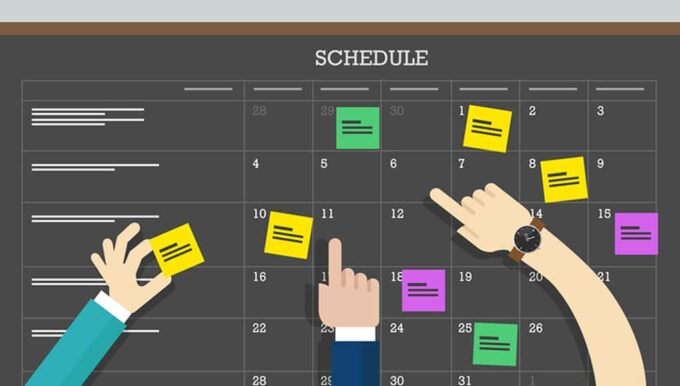For managers, creating a perfect work schedule for their employees is not a one-day exercise. The schedule must have room for revision and adjustments before getting the final copy, which takes more than a day. Such a process requires a good understanding of the business setup, whether it’s a 24-hour business or has a set time of operation daily.
The kind of schedule that employees get at work impacts their performance greatly. Therefore managers should strive to create a flexible schedule that balances the employee’s needs and companies.
Today, there are many ways of creating a flexible work schedule, like using the free schedule template from Track Time 24 available online, scheduling software, manually handwritten schedules, or excel schedules.
Basics about a Working Schedule

A good work schedule considers a few factors as discussed below to meet employee’s needs and the company’s.
- Staffing: A work schedule should ensure that all shifts are adequately staffed to avoid under or overstaffing.
- Flexibility: For the managing team, they need to understand the different waves of events that could affect staffing, for instance, parties in the middle of the week, holidays that could increase the number of customers, and the absence of employees.
- Error-free: A perfect work schedule should avoid basic errors such as double-scheduling, wrong scheduling of different positions.
With the basics of what an ideal work schedule looks like, here’s how to create the perfect schedule for your employees.
Know Your Staff to Build Shifts

As easy as it sounds, knowing your staff as a manager goes a long way. Getting to know their work capabilities, such as their skills, shift hours if it’s a shift job, and their line of preference concerning positions is crucial. With that data, it becomes easy to pick the right individual for specific tasks.
It also helps mix skills because different individuals perform differently. For instance, a manager can pick employees who are good at handling peak hours and mix them up with a few who are yet to learn the rope. Doing so ensures a balance in staffing, and the less experienced get mentored into the system.
Ensure there’s Proper Communication

For any system to function properly and smoothly, the management must establish a proper line of communication. The management should lead from the front line by ensuring providing the work schedule in advance for employee review.
They can then implement guidelines that govern how adjustments on the schedule get handled. For instance, they can have policies that stipulate periods within which employees hand in requests. When an employee is not available and there is prior communication, the management can manage to find a better person to fill in the position in good time.
Engage Your Staff on Scheduling

The entire burden does not have to fall on the management. Managers should learn to engage their staff when scheduling. Employees can get a view of the unfinished schedule for a limited set of time and list out their available hours and line of preference concerning their skills.
Managers can also allow employees to find their replacement when they are not available and make it known to the management on time for approval. Doing so makes employees feel a part of the system and that their needs and preferences are essential to the company. However, it is good to make sure the employees understand that the manager’s word is final.
Plan Ahead

Having a back-up and probably a plan C for your plan B as a scheduling manager is crucial. You do not want to find you are short of staffing. To prevent this from happening, a manager should compile an availability list for all their employees.
When an employee is not available and probably did not recommend a replacement, you can go through the availability list and pick a qualified and available colleague. The list can include part-time employees, employees who wish to be on stand-by, or potential employees from previous interviews.
Use Scheduling Software

Instead of relying on the hectic paperwork scheduling, and sometimes you might misplace the information, it is wise to consider good scheduling software. Effective scheduling software will allow you as a manager to perform various scheduling activities in one place where every detail is traceable when needed.
For instance, scheduling software can allow employees to go through the schedule before its completion and recommend adjustments where necessary, as mentioned above. The software can allow the managers to monitor each employee’s availability and keep track of their performance for future reference.
Creating a Word Schedule for your Employee: Excel Spreadsheet vs. Scheduling Software
Shift management is a huge task that can turn out overwhelming to shift managers. To ease your work, you can take advantage of an excel spreadsheet or an automated system to organize your employees.
What’s the difference between the two and which one is better?
Excel Spreadsheet

Excel spreadsheet scheduling system is a good solution if you need a quick fix. It is ideal for startups or companies with a few employees.
Here are some of its advantages:
- It’s cheap, suitable for managing a small team.
- It’s flexible. Allows you to customize formulas to suit your needs.
- Excel spreadsheet template is readily available.
However, this option has its fair share of challenges. For instance, you need more time to organize and manage data, and it lacks an effective communication medium. So you may need to rely on WhatsApp or text messages.
Scheduling Software

If your’re working with a large team, this option is the best and can improve your employee’s productivity. Advantages of a digital scheduling system
- Better efficiency; can manage many employees, reduce work and save time.
- Eliminates human errors.
- Offers effective communication with real-time visibility.
Which one is the best? It all depends on your purpose. To evaluate your business needs first to identify the best one for you.
Conclusion
Planning is essential in every administration for proper coordination and governance. A good work schedule is a useful planning tool that every business should consider as an investment. So, every manager aiming to create a work schedule for their employees should consider the above guide and implement it. Doing so safeguards employee’s interests and allow the company to achieve its goals.









